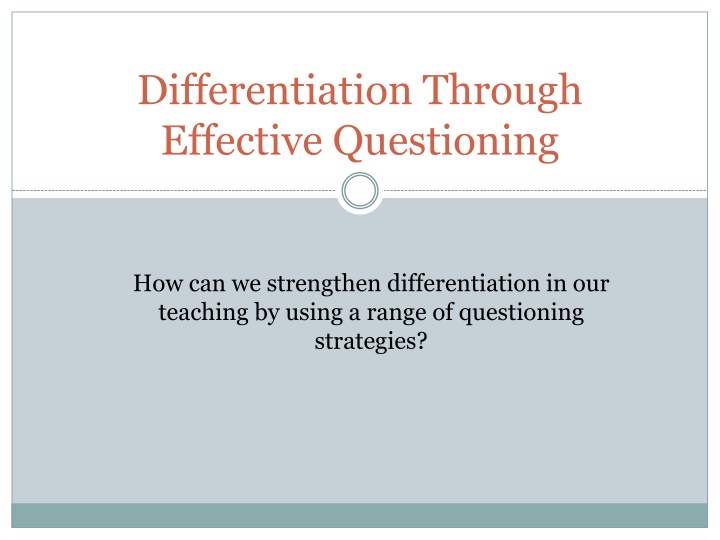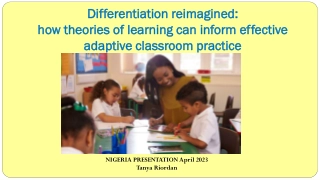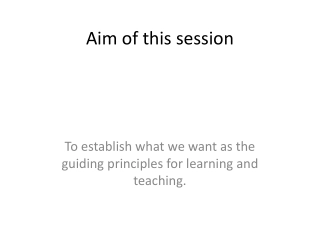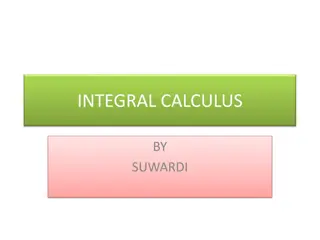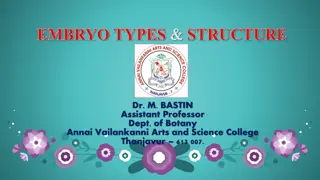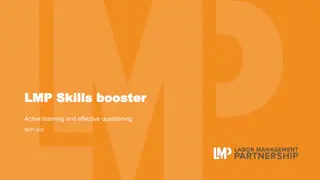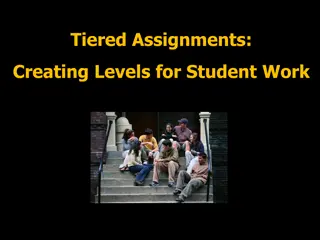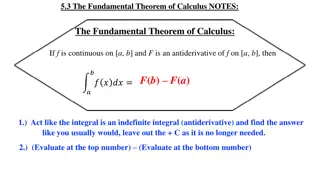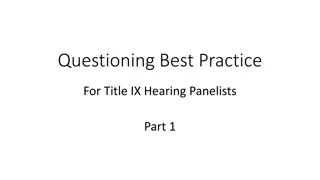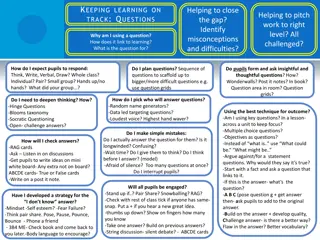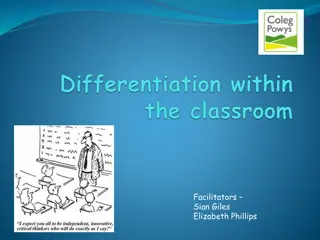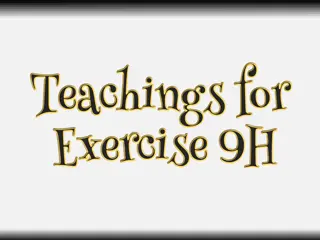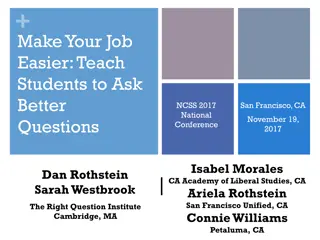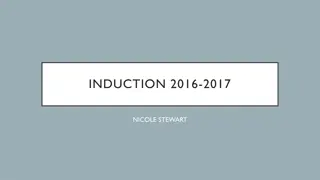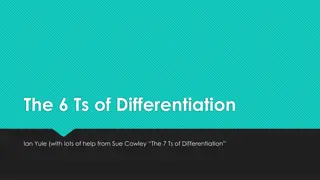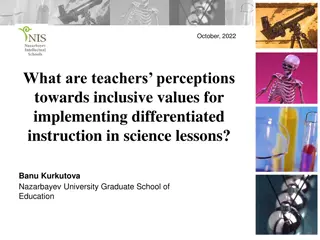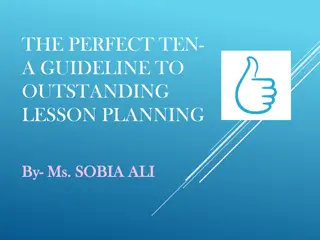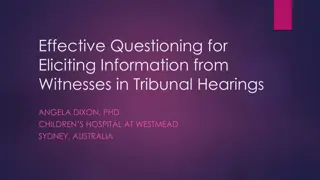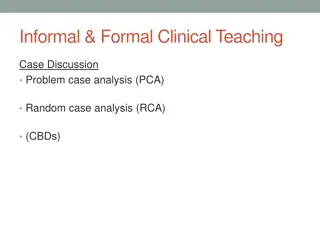Strengthening Differentiation Through Effective Questioning Strategies
Strengthening differentiation in teaching through a range of questioning strategies is crucial for promoting deeper thinking and engagement among students. By encouraging more questions and focusing on the process of inquiry, educators can ignite curiosity, creativity, and critical thinking skills. Utilizing tools like Thunk questions and open-ended queries can foster a supportive learning environment where diverse perspectives are valued. Effective questioning not only enhances student learning but also cultivates a culture of active participation and continuous growth.
Download Presentation

Please find below an Image/Link to download the presentation.
The content on the website is provided AS IS for your information and personal use only. It may not be sold, licensed, or shared on other websites without obtaining consent from the author.If you encounter any issues during the download, it is possible that the publisher has removed the file from their server.
You are allowed to download the files provided on this website for personal or commercial use, subject to the condition that they are used lawfully. All files are the property of their respective owners.
The content on the website is provided AS IS for your information and personal use only. It may not be sold, licensed, or shared on other websites without obtaining consent from the author.
E N D
Presentation Transcript
Differentiation Through Effective Questioning How can we strengthen differentiation in our teaching by using a range of questioning strategies?
What are the Purposes of Questioning? IN SCHOOL, we re OFTEN rewarded for having the answer, not for asking a good question, TED founder, Richard Wurman pointed out. Which may explain why kids who start off asking endless why and what if questions gradually ask fewer and fewer of them as they progress through school. A Newsweekstory The Creativity Crisis TALKS about signs of declining creativity among our school children. Interesting fact cited in the article: Preschool kids ask their parents an average of 100 questions a day. By middle school, they ve basically stopped asking questions. Around this time, the article points out, student motivation and engagement plummets. Which raises an interesting question: Have the kids stopped asking questions because they ve lost interest? Or have they lost interest because an answers-driven school system doesn t allow them to ask enough questions?
Try a Thunk Questions to stimulate deeper level thinking and get the brain going! Great for SMSC. There are NO right or wrong answers to these questions simply YOUR answers. You do, however, need to be able to justify your answers. Available from www.thunks.co.uk by Ian Gilbert
Try this thunk as a starter: If you could take a pill that meant you would never fail, would you? Take 20 seconds to think individually. Go around and each person must add one thought. When everyone has given one thought, any further thoughts can be discussed.
Video 42 seconds
Its a Fact Teachers ask around 70,000 questions a year and questioning accounts for up to a third of all teaching time. But are we asking the right questions to encourage learning or are we always just looking for the right answers?
Getting the right question to spark interest and debate There is no point in eating it all goes down the loo anyway! Should there always be a winner in sport? If there s no numbers in the question it is not Maths. What would the world be like if there were no individual countries? There is no point in studying history as it was all in the past. TASK: Think of a lesson you have taught this week and in particular a learning episode from within that lesson? Come up with an open question, that would provoke deeper thought and allow a range of responses to inform you about the depth of progress and understanding.
When and how to ask questions What is a hinge question? A hinge question is based on the important concept in a lesson that is critical for students to understand before you move on in the lesson. The question should fall about midway during the lesson or at any point where understanding the content is a prerequisite for the next chunk of learning Every student must respond to the question within two minutes You must be able to collect and interpret the responses from all students in 30 seconds It is the point where you move from one key activity/point on to another or assess who you need to support further.
Questions to test learning A. Alliteration B. Hyperbole C. Onomatopoeia D. Personification E. Simile Which sentence shows alliteration? Show using your fingers. 1. He was like a bull in a china shop. 2. This backpack weighs a ton. 3. The sweetly smiling sunshine 4. He honked his horn at the cyclist. 5. He was as tall as a house. All student All student response: response: Fist of five Fist of five
Questions to Diagnose Misconceptions Which of the following is the correct translation for I give the book to him ? A. Yo lo doy el libro. B. Yo doy le el libro. C. Yo le doy el libro. D. Yo doy lo el libro. E. Yo doy el libro le. F. Yo doy el libro lo.
Might allows greater imaginative thought When questioning, insert the word might to give students greater opportunity to explore possible answers. e.g. Instead of asking what is the meaning of Democracy, you could ask what might happen to you if you did not live in a democracy? What might the Great Depression look like today? The first infers a single answer known by the teacher whereas the second is inherently more open.
Post Hinge Strategies (Wave 1 Intervention) What can we do when half the class understands and half do not? Ask for red/amber/green for understanding. Students showing red move to sit next to student showing green. Students showing orange sit together. A new question is posed on which reds will explain how to answer to greens. Greens will then evaluates reds answer and then explain answer to a harder question. Oranges will work together. TASK: Discuss any further strategies that you use to provide support
Blooms Taxonomy To Help Differentiated Questioning Start small then raise the bar!
Examples in Art Remembering: List all the elements of art you can see in the artwork. Understanding: What does this artwork have in common with work you have seen before? Applying: How do you think the effects were achieved in this artwork? Analysing: What questions would you ask the artist about this artwork? Evaluating: Would you criticize anything about this artwork? Creating: What would you do to develop this artwork?
Examples in Maths Squares and Cubes Remembering: What are the first 5 square/cube numbers? Understanding: Why are 1, 4, 9, 16 called square numbers? Applying: How would you find the 15th square number? How would you show me that 441 is a square number? Analysing: Which is the square number closest to 30? Evaluating: The sum of two square numbers is 20 what are they? Creating: Create a cross number based on questions about square and cube numbers. TASK: Think of a question that could develop deeper thinking on a topic you are teaching. Break it down into different steps, working up to the higher level thinking skills.
Moving from Tennis Questioning to Basket Ball Questioning Getting away from I R E (initiation, response, evaluation) Is that right? What makes you so sure? What other information would help you sort out this problem? If you were allowed to guess anything, what would you say? What s the strength/weakness in your point? What do you think the main argument from others will be about that view? Tell me more.... Prove it..... Be prepared with a strategy for students who say I don t know . phone a friend for a hint or tip I ll come back to you, let s take a few other answers and you can choose If you did know, what would you say can anyone give a clue etc.
How long do you wait after posing a question? The average time allowed for students giving a response has been estimated at 1.5 seconds! The optimum time is nearer 5 seconds. How long do you give?
All student response systems a refresher! Timed pair share. Secret vote 1-2-3 show with whiteboards TASK: Discuss other strategies you use to ensure all students can think and respond to a question Pose, Pause, Bounce, Pounce POSE a question/topic PAUSE allow students ample time to think BOUNCE . ..the question out to a student POUNCE . ..now pounce on another student to provide a response, add to or critique another person s answer. This process can continue for as long as you believe the conversation adds to the learning.
Planning Ahead Think about a topic or lesson you will be teaching soon You could all do the same topic or different topics Spend about 8 minutes: planning for questions/ a question you could ask during that lesson to test understanding or deepen knowledge A strategy to ask that question that would ensure all students responded and provide an opportunity for developed questioning who you might ask specific questions to. Feedback to the rest of the group about what you intend to trial/develop
Teaching and Learning Facilitators Guide 19th Jan Resources needed: Ppt presentation on Differentiation through Questioning (V:\Differentiation\Questioning) Personal Action Plan sheet Stopwatch or something to time activities with Introduction and starter (5 minutes) Introduce ppt and present learning intentions on slide 1 and 2 to consider how questioning can be used to strengthen differentiation in the classroom Participants engage in the starter activity slides 3 and 4 New learning about differentiation (30 minutes) Introduce the rest of ppt about Differentiation through Questioning. Complete the tasks as you go along. Personal action planning (10 minutes) Colleagues to spend time completing the personal action plan in detail on what they hope to accomplish before the next meeting on 23rd March. This may include trying out new ideas or it may simply be to consolidate techniques with which they have already experimented. This is also a good time to plan any peer observations in order to seek out support/time/cover etc.. Summary of learning (10 minutes) In the final part of the meeting, ask colleagues to feedback on the actions they have set themselves.
